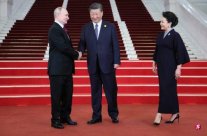The 3rd "Belt and Road" International Cooperation Summit Forum will open on Wednesday (October 18) in Beijing. This is the most important home diplomacy of China before the end of this year.According to official news, representatives of more than 140 countries and more than 30 international organizations confirmed the participation, and the number of participants in the conference exceeded 4,000.
This scale is slightly inferior to the second summit forum in 2019.Four years ago, more than 150 countries and more than 92 international organizations participated in the conference.The heads of state and government of 38 countries including China, as well as 40 leaders including the Secretary -General of the United Nations and the president of the International Monetary Fund, also participated in a round -table summit at the time to publish a joint communique on the “Belt and Road”.
The official head of state, government head, or head of international organizations who have not yet attended the Summit Forum this year.Judging from the foreign guests who have arrived in Beijing in the past two days, Russian President Putin, which is deeply trapped in the quagmire of the Russian and Ukraine war, is the highest foreign guest of "coffee".
As the "Belt and Road" initiative, the national strategy, is the world's largest infrastructure construction platform.This proposal for 10 years is also the most iconic foreign policy since the current Chinese leader.
The outside world's evaluation of this initiative is semi -mixed.Over the years, the “Belt and Road” has filled the vacancy of global infrastructure. Many developing countries have built railways, bridges, ports, and industrial parks.
According to a report released by the University of Boston in the United States this month, China provided at least $ 331 billion (S $ 453 billion in S $ 453 billion) from 2013 to 2021, and African countries received US $ 91 billion.The report believes that compared with traditional development financing institutions such as the World Bank, China's overseas development financing is more focused on industrial and infrastructure loans. Therefore, it has a closer relationship with economic growth and solving infrastructure bottlenecks and energy reaching energy.
However, disputes around the “Belt and Road” have never stopped, and the most criticized is that it puts poverty -stricken developing countries into debt difficulties.The report of the University of Boston also pointed out that the "Belt and Road" project has also constitutes risks to climate change and local biological diversity over the years.
In addition, some "Belt and Road" investment has also triggered problems such as "white elephant engineering" and corruption, and even because of lack of understanding of cultural customs and becoming a good thing to do bad things.A African Ambassador to China mentioned a real case of crying and laughing in a discussion on China's sovereignty financing on African countries last week.In order to solve the problem of drinking water, his country spent a lot of money in the local area to drill in remote areas. He also specially held the completion ceremony for the project.After two or three years of drilling, almost no one went there to take water.Inquiring carefully, the local people had the reason why this drill was not leaned on the ancestral grave of the locals.
In the description of the West, the "Belt and Road" is also a means of sacrificing the interests of other countries to the interests of other countries, promoting its strategic, political, diplomatic, and economic influence, and even described as the "Chinese version of Marshall Plan".
The various criticisms of the "Belt and Road" are not completely fair, and there are many political colors behind them.In all fairness, such a large -scale and ambitious plan, even if the original intention is justified, will always encounter problems.Many developing countries in the "Belt and Road" projects are not in the rule of law in the rule of law. There are also problems such as corruption and low efficiency of officials. Cultural conflicts are superimposed, and the project will inevitably encounter setbacks.
However, the design of many projects in the “Belt and Road” is too extensive. Without careful planning and demonstration, the lack of standards in implementation has also caused a lot of avoided problems.In addition, although China emphasizes the "Belt and Road" as a common development opportunity, Beijing projected international influence through the "Belt and Road", expand bilateral relations with the Third World State through this carrier, and establish one more option outside the Western -dominated world order.This is also the fact.
All signs show that during the three -year epidemic period, China ’s loans and construction under the“ Belt and Road ”are decreasing. Some scholars described that the“ Belt and Road ”had been in a long time.The outside world is now highly concerned. How can China plan its future when this initiative proposes its 10th anniversary?
Compared with 10 years ago, the "Belt and Road" environment faced the different past.China's domestic economy is weak, the youth unemployment rate is high, the real estate industry is frequent mines, and the extensive large -handed investment is not sustainable. Domestic people are not happy to see the country's "spending money to buy influence".
The international environment has also changed profoundly.When the "Belt and Road" initiative was proposed, the world is on the climax of globalization. The concept of building infrastructure and promoting interconnection interaction is still very popular. Nowadays, the trend of thinking of globalization and decoustal disconnection chain is prevailing.It also makes the world at risk of division, which is not conducive to the promotion of integration.
In the turbulent situation, China needs to continue to promote the "Belt and Road" initiative, and the world needs cooperation.Judging from many international participants in this summit forum, the "Belt and Road" is still valued.So, how China summarizes experience and lessons in the past 10 years, re -adjusts its positioning, and uses a practical action to shape the cooperation model of standardized, rule of law, openness, tolerance, and mutual benefit.Restore the vitality.



